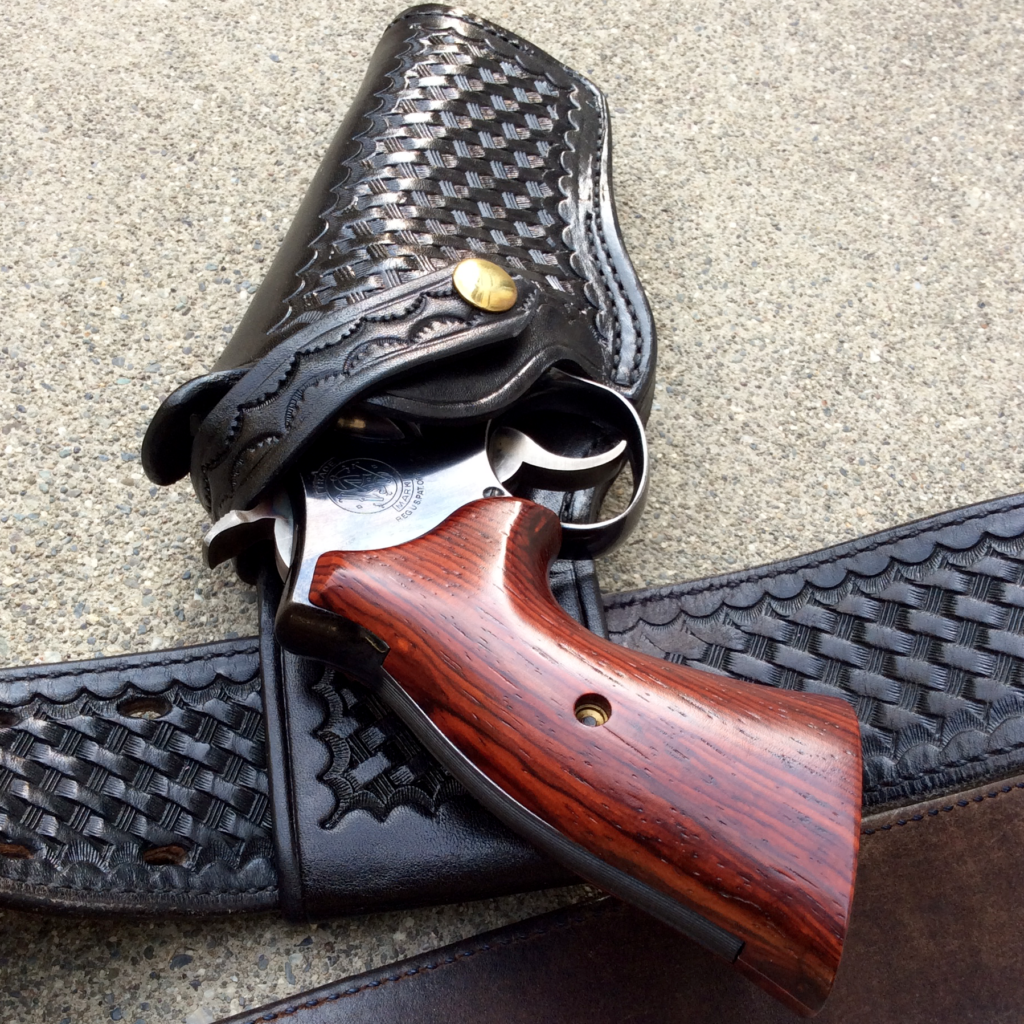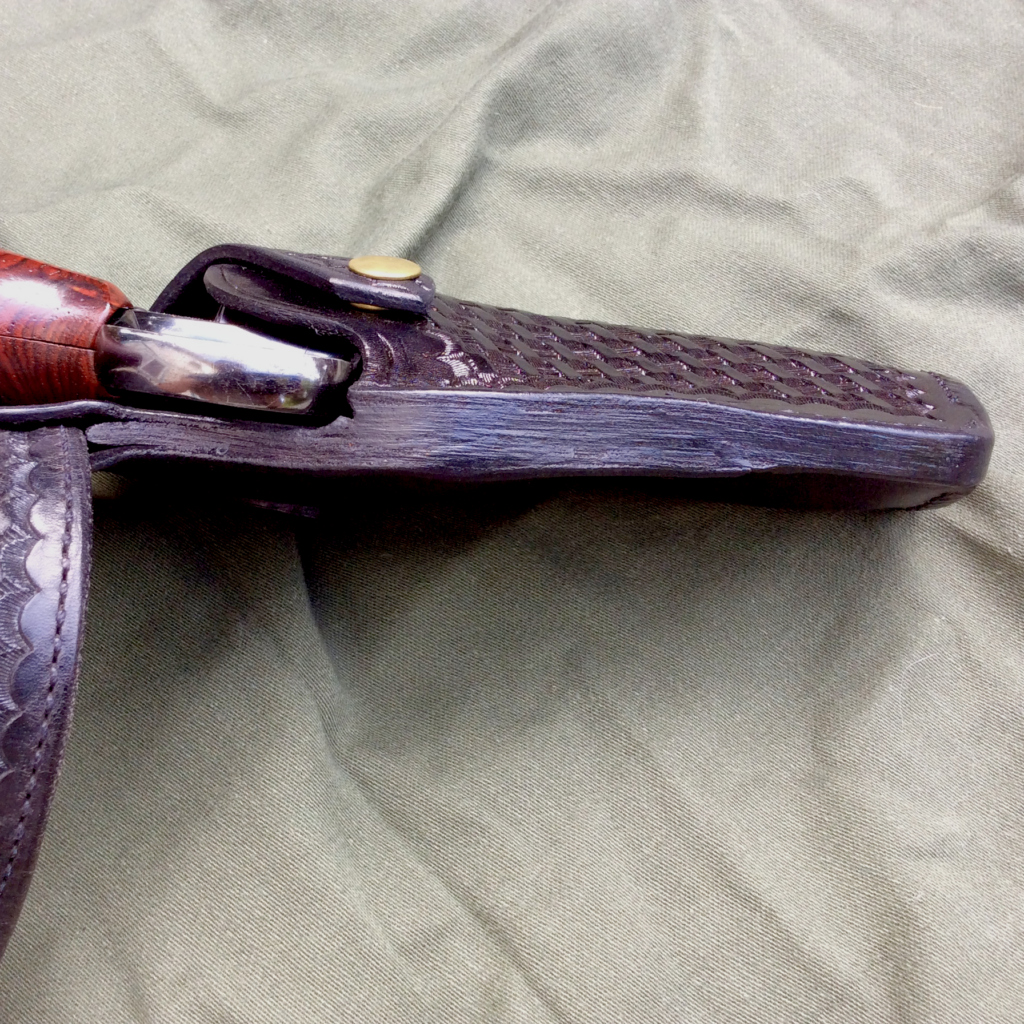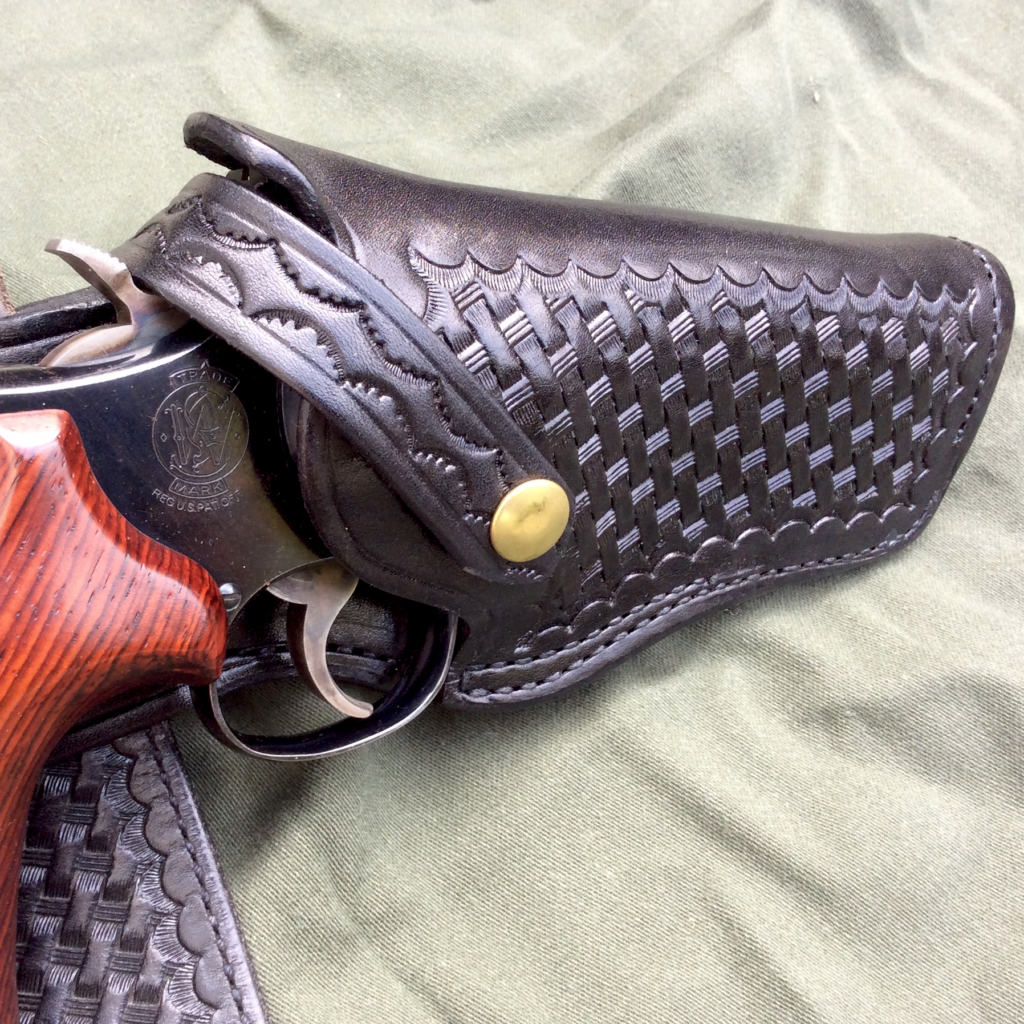Is there anything sweeter to a RevolverGuy than packing a classic revolver in a classic holster made out of premium leather? I have to admit that I spend more time carrying guns (bottom feeders, no less!) in polymer holsters these days, but my revolvers all ride in cow or horse hide. I won’t deny that modern chemistry has given us some wonderful materials to make belts and holsters from, but my round guns will always get holstered in leather, thank you very much.
Luckily for me, Justin understands this quirk in my nature. He might pack his 640 Pro in a polymer holster worn on a nylon riggers belt, but he still gets the fact that custom leather rigs are special, and that some guns deserve them. Recently, in a wonderful, RevolverGuy type of gesture, he gave me a Jordan holster for my cherished Smith & Wesson Combat Magnum. It’s a beautiful rig, and I’d like to give you a tour of it.
A match made in . . . Texas?
Now, if there has ever been a more natural pairing of steel and leather, I’m not sure what it is. Some of you guys with the cool hats and spurs might cast a vote for the Single Action Army in a Mexican Loop, and I’d give you that, but you’ve gotta admit there’s a strong argument to be made for carrying the gun inspired by Bill Jordan—the “peace officer’s dream”—in a holster designed by the legendary border lawman, himself.

We’ve got an article about the Combat Magnum in the works for you, but for now it’s enough to say that not only is it one of Smith & Wesson’s all time greatest achievements, it’s also a personal favorite of mine. I’m thankful that Smith & Wesson President Carl Hellstrom listened to the Texas lawman when he described the features necessary to create the ultimate medium-frame duty revolver. My own sample of the Combat Magnum wasn’t babied by its previous owners, so it’s a little worn in places, but I love it all the same.
Knowing my affinity for the gun, Justin wanted to get me a proper holster for it. The obvious choice was a Jordan-style holster but where to find one? There’s a lot of great holster makers out there these days, but to pull off this project, he went to a place with a history as rich as the holster itself: Tex Shoemaker & Sons, Inc.
About Tex
Loren “Tex” Shoemaker learned the leather business as a high schooler in the San Gabriel Valley of California in the late 1920s. He learned how to hand tool and carve leather from some of the best in the business, and by 1936 he had started doing jobs for his fellow policemen out of his garage (Tex served in law enforcement for 33 years, including 25 as a deputy sheriff in Los Angeles). Soon, he added a shop to the side of the garage, and when demand exceeded his ability to supply, he upgraded to a bigger facility. In very little time, Tex Shoemaker & Sons became one of the major players in the police leather goods industry.
Today, Tex Shoemaker is run by Tex’s grandson, Doug, who still makes some of the best police holsters, belts, and duty gear in the business, using equipment and techniques handed down by his grandfather. I was able to talk with Doug about the holster he made for me, a Model 50 Jordan-style holster with a snap-on back, and as a fellow RevolverGuy, I think you may enjoy hearing more about it.
Building a Tex Shoemaker Jordan
My Jordan holster started with high quality, second grade cow hide with no blemishes. This leather is beautiful, strong and durable, but also economical for the consumer—first grade leather would be too cost prohibitive for most of us.
Using special templates, this tanned leather is cut to the proper shape and size for the gun that the holster is being made for. On holsters like mine, a special die that measures about 4” wide by 10” long is used to stamp the basketweave pattern into the wetted leather. The die doesn’t finish the edges of the basketweave pattern, however, so Doug completes the edges by hand, applying a beautiful scalloped pattern to the border of the stamped areas.
The pieces of the pattern are wrapped around a form in the shape of the gun and are sewn using machines that stitch them together with nylon thread (nylon will resist rot better than cotton or waxed linen). A careful eye will note that the high stress area on the rear seam of the pouch, just under the trigger guard, is backstitched several inches for extra strength.
In the Jordan-style holster, a metal shank is sandwiched between the layers of leather, to provide rigidity and to maintain the cant and shape of the pouch, per Jordan’s original design intent. On the Tex Shoemaker version of the Jordan, this metal shank does not go up the backside of the loop and over the top of the belt, which makes it similar to the earlier Askins-style Border Patrol holster, with its leather-only drop loop. This means that the Shoemaker interpretation of the Jordan can’t be bent and twisted to hold the offset shape that Jordan specified for maximum speed, but there are benefits to this design choice that we’ll discuss later.
The loop on my holster has snaps to facilitate easy removal and donning without undoing the belt, which would prevent the use of a shanked loop anyhow. A holster of this design is featured in Jordan’s seminal book, No Second Place Winner, so the design is period-correct.

During assembly, the safety strap is attached to the holster body with a rivet whose back is covered by the interior leather to protect the gun’s finish. The wetted holster is lightly boned around the form, to ensure the pocket will fit the gun well. On my Jordan-style holster, the protective leather guard for the rear sight is properly shaped so it will do its job, and the muzzle plug (a standard feature of the Jordan design, rarely seen these days in duty holsters) is sewn into position. Doug explains that in the old days, the muzzle plug was sewn using a machine that stitched at a 45 degree angle, but in recent years, when parts could no longer be obtained to keep the old machine running, they switched to making the holster body slightly longer than required for the barrel length, so that the plug can be stitched into place from the side without interfering with gun fit.
After assembly is complete, the edges are sanded smooth and the rig is dyed black, then waxed. Doug uses a water-based finish to make the rig shine, that’s applied with a sponge to penetrate into all the depths of the basketweave pattern. Just brushing it on would hit the ridges, but miss the valleys in the pattern. Usually it takes two coats to get a good seal on the leather, and the rig is allowed to air dry before it’s buffed to a beautiful sheen.

Living and working with the Shoemaker Jordan
The Tex Shoemaker Jordan holster is a beautiful and high quality rig, and the perfect complement to my Combat Magnum.
Because the Shoemaker version doesn’t have a full length metal shank in the loop, you can’t contort it to hold the offset position that Jordan favored, where the grip hovered out away from the body. This is one of those things that has pluses and minuses. On the negative side, the grip of the gun rides close to the backside of the holster, and you have to wedge your fingertips between the leather and the gun to wrap your fingers around the butt and establish your grasp. I won’t lie, this can be awkward and a little slow, especially when you’re learning the draw from this new holster, but as the loop leather breaks in a bit, the gap will probably get a little bigger and it will be easier to lever the gun away to establish the grasp. Still, it feels weird for those of us who are used to an unimpeded grip.
On the plus side, the Shoemaker Jordan rides very close to the body, and your gun isn’t hanging out there like a giant tumor on your hip, where it will catch on and bang into everything you walk close to. If you go into a police station where offset, drop loop holsters of the Jordan style are carried by the officers, you’ll notice that all the door jambs, furniture and walls have dings and scrapes at waist level, where the officers are constantly banging their guns into them (the grips on their guns will look like they were attacked by an angry Dremel tool, too). That can be hard on your gun, especially the more fragile parts like rear sights, so a holster built like the Shoemaker version will do a better job of protecting the gun. It will also make it easier for you to get out of your vehicle without getting hung up on the steering wheel, window pillar, or door.
The safety strap on my Shoemaker Jordan has a short tail on it, beyond the snap. This means that you have to use your fingertips to pop it open, because there’s not enough purchase on it to reliably use the side of your thumb in an upward sweeping motion to open it. Doug can make you a strap with a longer tail, if that’s what you’d like on yours, but he cautions that sometimes the longer tail can be easier to catch on something like a seatbelt or a chair arm, and accidentally pop the snap.

For somebody like me, who grew up using holsters with thumb breaks for personal carry and duty, using a holster with a safety strap is really foreign. I’m working on it, but I’m definitely neither smooth or fast. There’s just too much learning and habit to overcome. Honestly, even the best coppers were slower with their safety strap Jordans than they were with the thumb break versions that became so popular by the late 70s and early 80s. The thumb break is just much more efficient, which is why Doug sells a lot more of his Model 35 Jordan-style holsters, which are equipped with thumb breaks in lieu of the strap.
Revolver Guy Magic
For me though, I’m glad I got the Model 50 with the traditional strap. Let’s face it: I’m not going to be carrying this as a duty or a competition rig. This is a rig that I’ll wear for the sheer enjoyment of it. This is a rig that I’ll wear when I want to connect with the little kid that’s still inside of me, who grew up watching all the westerns and police shows, and whose heroes all wore badges. I’m thankful that my rig looks exactly like the ones worn by all those border patrolmen, deputies, coppers and highway patrolmen from the 1940s through the 1970s, and by Jordan himself in his book. It’s more fun that way.
The Tex Shoemaker & Sons Jordan-style holster is a great tribute to the design. It’s beautifully executed, durable, and handsome. It has the wonderful smell and creak of leather that I remember from the days when Dad wore his Sam Browne with the 6” Colt hanging at his side. Mine even has the “correct” brass hardware, to match the buckle on Dad’s old duty belt, which will carry it in style.

When I belt it on, I’m magically transported back to a time when life in America was simpler and better, yet I’m also reminded of the special friend from the present day, who was insightful enough to realize it was exactly what I needed, and thoughtful enough to give it to me. Thanks buddy!
Tex Shoemaker & Sons is a custom shop, and if it’s made out of leather and used to carry a gun or related gear, they can make it for you. If you need a special rig to carry an old favorite, or just a hard working holster for your everyday carry or duty gun, give Doug a call and tell him that you heard about him here.
Don’t wait too long though. In an age of plastics and mass production, it’s getting increasingly difficult for old world craftsmen like Shoemaker to keep the doors open. If you have even the slightest thought of placing an order, saddle up and get yourself over to Tex Shoemaker right away. Don’t miss out on the chance to get your own little bit of RevolverGuy magic in leather.


Now you need to run that in a class!
Sadly, I just recently read that Tex Shoemaker have closed their doors. O
Jim,
They haven’t closed them quite yet. They’ve extended their closing date a bit to accomodate the flood of orders received when they let folks know they were closing. If you want a Tex Shoemaker Jordan there’s still time! Tex Shoemaker & Sons will be accepting orders through Tuesday October 31st, so don’t hesitate!
Justin
I worked the old San Dimas station in the 80’s. Tex was retired but would stop by regularly. Nice man and prior to meeting him I had already purchased one of his holsters. Sad to see they are now closed.
What a fine piece of gunleather, Mike! I couldn’t agree more that sidearms are supposed to live in something organic and alive… and that although plastic holsters certainly are popular these days, a proper gentleman’s gun of heavy blue steel deserves what God intended.
Love the grips on that Combat Magnum, too. Looking forward to the story on that.
Justin, you did good…
Thanks Jeff! I’ve been hogging the bandwidth lately, so I’ll be back later with the Combat Magnum saga, after Justin gets his blog back for a while. ; ^ )
That’s neat, Walt. I hope you still have some of your old Tex gear in your collection?
It’s disappointing that old world craftsmen like the Shoemaker family are struggling in our new, disposable economy. There are certainly many benefits to modern materials and manufacturing, but a plastic holster will never be the keepsake that a hand-tooled leather holster will be.
Tex Shoemaker has already extended the ordering window once, as a result of a surge in orders that came after the closure announcement. Although they are currently announcing they will take orders through the 31st of October, that could change again if the interest remains strong. It would be great if we could keep moving that date to the right, and keep them around just a little longer.
One thing’s for sure–if you want to get a Shoemaker product, the time is now. Don’t delay, or it might be too late!
If only open carry was socially acceptable… I can justify just about anything, but I couldn’t justify a Shoemaker Jordan holster before they went out of business. It would have been a 100% pure collectable, and the pragmatic side of me says I have to at least get some possible use out of the thing. Maybe if I lived in a rural area and had land to attend to, but that’s not my life.
Enjoy that beautiful piece of history – it’s a grand holster with a grand story behind it.